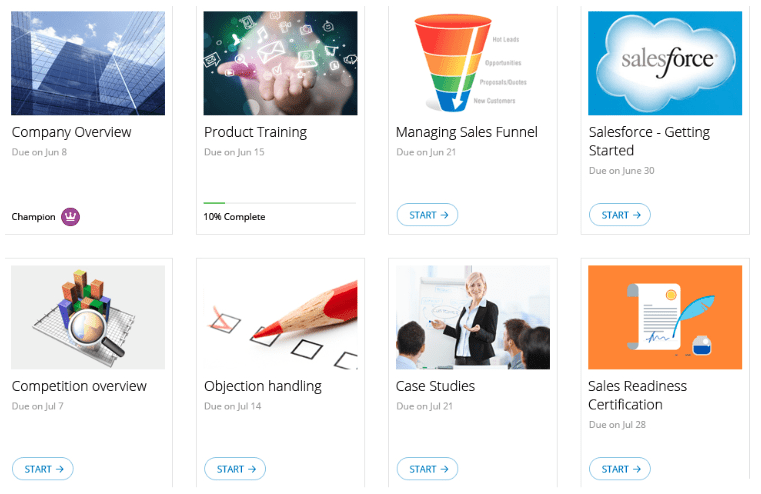As the director or manager for sales enablement, you’ve probably been more focused on tracking participation metrics, like a number of training sessions completed, amount of content produced, and so on (a whopping 48% of enablement managers track only that). And it’s understandable. These metrics give you an idea about the engagement level of learners and the effectiveness of the content produced by your team. Fair enough!
While these participation metrics are important to you when measuring the success of your sales enablement strategy, the positive impact of your efforts on revenue may not be as readily apparent to senior management. And expecting them to calculate the impact on revenue themselves may be wishful at best.
You have to make them see the revenue impact of your enablement initiatives by spelling it out for them — clearly and logically. This will frame their perception of the value your function is contributing to the organization.
Measuring the impact of sales enablement on business metrics is not straightforward
With marketing, it’s easy – traffic and leads are your go-to metrics. With sales — it is revenue generated and the number of deals closed. But what is it for sales enablement? There’s no one metric that can tell you the business impact of your efforts.
There will most probably be external factors that are influencing the business metrics you need to track. You cannot claim that the improvement in quota attainment is solely because of the efforts of sales enablement, for example. It may have played a crucial role, yes, but maybe reworking the talent acquisition strategy helped the HR department find better candidates this time as well. Possible, right?
Measuring the exact numbers are thus not so straightforward for enablement managers. Many take the approach of showing estimated revenue impact of their efforts — and that’s okay!
Here’s how you should go about it.
Proving the worth of your sales enablement efforts – Metrics to track
Metric 1: New hire ramp-up time
Cutting down the “time to productivity” is one of the primary parameters that can help you prove the effectiveness of your onboarding efforts.
Did you know that the latest inside sales report by The Bridge Group revealed that five months (and growing) was the average ramp-up time for new hires in SaaS companies
That’s a major red flag, especially when the average tenure of a rep is reported to be only 2.5 years.
Now let’s assume you have 20 new reps each with a quota of $1M per year, and you manage to reduce their average ramp-up time by one month. This means your onboarding program contributed $1.6M ($83,333 x 20) additional revenue, every year.
Closely tied with actual business results, interpreting the revenue value of ramp-up time is pretty simple. How companies measure this metric varies immensely though, and depends on every company’s unique business context.
Tom Levey, the Senior Director for Sales Enablement at AppDynamics, for example, tracks the time to close the first $50K deal as the main metric to report the effectiveness of his onboarding programs. Like Tom, many sales enablement leaders prefer to track reps’ time to the first sale as their criteria to measure ramp-up time.
How you can improve on this metric:
Create a progressive, milestone-based onboarding plan. Map out the objectives according to the ramp up time that is appropriate for your business. A typical onboarding plan may look something like this:
- First 30 days: Ensure all new reps have a thorough knowledge of processes and basic product knowledge.
- 30-60 days: Clear articulation of the value proposition, basic objection handling, and how to use best practices.
- 90-days: First sale worth over $50k made without any hand-holding.
Set the timelines and objectives according to your unique business context. Once you have this structure clearly laid out, it will help your reps focus their energies to accomplish the objectives. This will also push you to create very focused training material.
At the end of every week, you can identify slow learners, who are unable to reach the expected performance benchmark and need more attention.
Provide the right blend of online and in-person training opportunities to get new hires up to speed quickly. Reserve the latter to clear doubts, practice different sales scenarios, and discuss advanced topics, like the competitive landscape.
Assign scenario-based role-plays to help your reps become customer-ready faster. While the online training may build the baseline knowledge of your new reps, role plays help them gain confidence to master common customer conversations with ease.
Metric 2: Win rate
While an aggregate improvement in win rate is a big plus in your enablement report, segmenting this data will help you find useful insights to determine the course of your enablement strategy.
Show win/loss rate against specific competitors in your report. Over a period of time, you can prove how you are influencing your win rate against specific competitors by channelling your efforts.
How you can improve on this metric:
- Equip your sales team with battle-cards and competitive intelligence that help them frame strong rebuttals and competitive moats.
- Identify the gaps that are impacting your B players’ ability to close deals. This is the low hanging fruit you can work on first. Your access to data might be limited, which means you may only see the aggregate win rate. But if you can segment the data by geography or cohorts and evaluate win/loss rates of different sales teams and their knowledge levels, you might be able to identify valuable insights (you can do this if you use Mindtickle). You can then create specific training programs for teams that are falling short. Adding some actionable industry insights to the report might also be a good idea. For example, if you notice that reps in a particular cohort group are selling well in a particular industry or territory, you can understand what is working for them and share any relevant knowledge with the other teams. The impact of these insights on the other teams can then be measured and the results shared.
Metric 3: Percentage of reps achieving their quotas
In sales, everything boils down to the metric of quota attainment. Recent research noted that only 61% of reps in SaaS businesses achieve their quota. That means there’s an opportunity for sales enablement managers to improve 39% of the laggards.
Achieving an improvement in quota attainment can help you make a solid case that demonstrates all your training is not just about ‘knowledge addition’ for reps. It is actually bridging relevant, carefully-identified information gaps, to help your reps close more deals.
So if 30% of your reps attained quota last quarter; and this quarter it rose to 45%, you can for example, attribute that to your competitive insights initiatives that helped reps handle objections effectively and win more deals. Multiply this by the number of reps you have, and you can show how this improvement escalated the revenue impact for the business.
How you can improve this metric:
- Identify the difference between learning patterns of achievers and laggards. Let’s say you find that all reps who achieve their quota have completed their ‘Objection Handling course for competitor A.’ You can make it mandatory for all reps to complete this course and measure its impact.
- Start off with reasons why your reps are not reaching their quota and then fix them. If, for example, you find out their product knowledge is not up to the mark, you can conduct quizzes around different aspects of product knowledge to identify gaps and create courses to bridge these gaps.
- Implement a 4-week quiz plan by segregating questions in four knowledge buckets — value proposition, competitive intelligence, case studies, and product knowledge. Roll out 3-4 questions every week to collect data and identify the knowledge gap that might be impacting your reps’ ability to win deals.
Metric 4: Sales cycle
The B2B buyer journey has become more complicated. And thanks to the involvement of multiple decision-makers, the average length of a sales cycle has gone up by over 22% in the past five years.
It’s simple — shorter sales cycle = more deals to close = more revenue. The maths is right, the impact is clear.
But reducing the sales cycle isn’t that simple! And this is especially because unless you do something groundbreaking, you’ll only be able to see the impact of your efforts reflected in the sales cycle over a period of time. Reducing sales cycle is thus more of a long-term objective for enablement managers.
As reducing the sales cycle is something that takes time, it makes sense to show the sales cycle in your report only once or twice a year. You can also show the revenue impact on compressing the cycle. For example, if you reduce the sales cycle by 10 days (down from the average duration of 4 months) and your average deal size is $20k — your estimated revenue impact could be $50-$100K additional revenue for every sales rep every year.
How you can improve this metric:
Sales cycle and win rates are interrelated. A lot of things that you can do to improve win rates will reduce your sales cycle as well. Apart from the suggestions mentioned above, here are few other things you can do to reduce your sales cycle:
- Work with sales operations to identify the biggest drop off stage in your sales funnel. Hubspot was a pioneer when it came to implementing a data-driven approach to coaching. Mark Roberge, their VP Sales, talks about it in this For entrepreneur article. As an example, Mark suggests that if they see drop-offs at ‘worked-lead to demo conversions’ of their sales funnel, they usually break it down to find out if reps are struggling to connect with the prospects, or whether they are able to get in touch but unable to get their time for the demo. Depending on their findings, the coaching strategy is defined for maximum impact.
- Next time you’re trying to decide on a sales enablement campaign or initiative, ask yourself just one question — ‘Will this information help my reps close more deals?’ If the answer is ‘no,’ discard the idea and move onto the next one. This will keep you laser-focused on the end impact and help you improve your metrics over time.
- With Mindtickle customers, we’ve seen time and again that it is not about the number of content modules you create per month. You need to share relevant and high-quality content to trigger engagement amongst your reps and give them a reason to keep coming back to learn more. Recognizing the challenges and problems faced by reps plays a huge role in the success of your enablement efforts here.
And although the metrics given above are super important, don’t forget to track engagement metrics. While it might not be of supreme value to your business heads, it will definitely provide you with great insights that give you direction for effective enablement.
What metrics do you track to prove the impact of your enablement efforts? Tell us more about it in the comments section.







